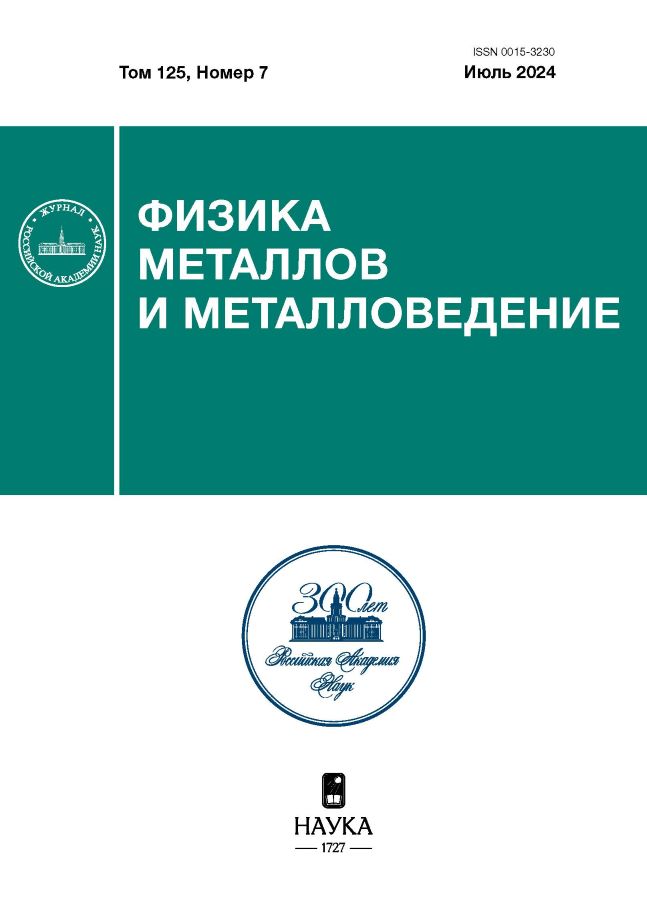A study of structure of metastable Cu–Zn alloys with shape memory effect
- Авторлар: Svirid A.E.1, Kuranova N.N.1, Pushin V.G.1, Afanas’ev S.V.1
-
Мекемелер:
- Mikheev Institute of Metal Physics, Ural Branch, Russian Academy of Sciences
- Шығарылым: Том 125, № 7 (2024)
- Беттер: 821-830
- Бөлім: СТРУКТУРА, ФАЗОВЫЕ ПРЕВРАЩЕНИЯ И ДИФФУЗИЯ
- URL: https://innoscience.ru/0015-3230/article/view/681037
- DOI: https://doi.org/10.31857/S0015323024070055
- EDN: https://elibrary.ru/JRMZZY
- ID: 681037
Дәйексөз келтіру
Аннотация
Methods of transmission and scanning electron microscopy are used to study premartenstic states and their relation to martensitic transformations in the alloys Cu–38 wt% Zn and Cu–39.5 wt% Zn with shape memory effect. Analysis of the observed diffusion scattering of electrons is carried out, including in situ experiments at heating and cooling and the defect condition of the internal substructure of austenite and martensite. The crystallographic models of martensitic transitions β2 →β2′, β2 →β2′′, and β2 →γ2′ are proposed based on the crystallographic data obtained in the premartensitic state.
Толық мәтін
Авторлар туралы
A. Svirid
Mikheev Institute of Metal Physics, Ural Branch, Russian Academy of Sciences
Хат алмасуға жауапты Автор.
Email: svirid@imp.uran.ru
Ресей, Ekaterinburg, 620108
N. Kuranova
Mikheev Institute of Metal Physics, Ural Branch, Russian Academy of Sciences
Email: svirid@imp.uran.ru
Ресей, Ekaterinburg, 620108
V. Pushin
Mikheev Institute of Metal Physics, Ural Branch, Russian Academy of Sciences
Email: svirid@imp.uran.ru
Ресей, Ekaterinburg, 620108
S. Afanas’ev
Mikheev Institute of Metal Physics, Ural Branch, Russian Academy of Sciences
Email: svirid@imp.uran.ru
Ресей, Ekaterinburg, 620108
Әдебиет тізімі
- Perkins J. Ed. Shape Memory Effects in Alloys. Plenum. London: UK, 1975. 583 p.
- Варлимонт Х., Дилей Л. Мартенситные превращения в сплавах на основе меди, серебра и золота. М.: Наука, 1980. 205 с.
- Ооцука К., Симидзу К., Судзуки Ю., Сэкигути Ю., Тадаки Ц., Хомма Т., Миядзаки С. Сплавы с эффектом памяти формы. М.: Металлургия, 1990. 224 с.
- Duering T.W., Melton K.L., Stockel D., Wayman C.M. (Eds.) Engineering Aspects of Shape Memory Alloys. Butterworth-Heineman: London, UK, 1990. 512 p.
- Хачин В.Н., Пушин В.Г., Кондратьев В.В. Никелид титана: Структура и свойства. Москва: Наука, 1992. 160 с.
- Пушин В.Г., Кондратьев В.В., Хачин В.Н. Предпереходные явления и мартенситные превращения. Екатеринбург: УрО РАН, 1998. 368 с.
- Лободюк В.А., Коваль Ю.Н., Пушин В.Г. Кристаллоструктурные особенности предпереходных явлений и термоупругих мартенситных превращений в сплавах цветных металлов // ФММ. 2011. Т. 111. № 2. С. 169–194.
- Bonnot E., Romero R., Mañosa L., Vives E., Planes A. Elastocaloric effect associated with the martensitic transition in shape-memory alloys // Phys. Rev. Lett. 2008. V. 100. P. 125901.
- Planes A., Mañosa L., Acet M. Magnetocaloric effect and its relation to shapememory properties in ferromagnetic Heusler alloys // J. Phys. Condensed Matter. 2009. V. 21. P. 233201.
- Cui J., Wu Y., Muehlbauer J., Hwang Y., Radermacher R., Fackler S., Wuttig M., Takeuchi I. Demonstration of high efficiency elastocaloric cooling with large δT using NiTi wires // Appl. Phys. Lett. 2012. V. 101. P. 073904.
- Mañosa L., Jarque-Farnos S., Vives E., Planes A. Large temperature span and giant refrigerant capacity in elastocaloric Cu–Zn–Al shape memory alloys // Appl. Phys. Lett. 2013. V. 103. P. 211904.
- Волков А.Е., Иночкина И.В. Модель обратимой памяти формы мартенситного типа в материалах с термоупругим превращением // Вестник ТГУ. 1998. Т. 3. С. 231–233.
- Razumov I., Gornostyrev Yu. Role of magnetism in lattice instability and martensitic transformation of Heusler alloys // Metals. 2023. V. 13. P. 843.
- Dasgupta R. A look into Сu-based shape memory alloys: Present Scenario and future prospects // J. Mater. Res. 2014. V. 29. № 16. P. 1681–1698.
- Pushin V., Kuranova N., Marchenkova E., Pushin A. Designand Development of Ti–Ni, Ni–Mn–Ga and Cu–Al–Ni-based Alloys with High and Low Temperature Shape Memory Effects // Materials. 2019. V. 12. P. 2616–2640.
- Лукьянов А.В., Пушин В.Г., Куранова Н.Н., Свирид А.Э., Уксусников А.Н., Устюгов Ю.М., Гундеров Д.В. Влияние термомеханической обработки на структурно-фазовые превращения в сплаве Cu-14Al-3Ni с эффектом памяти формы, подвергнутом кручению под высоким давлением // ФММ. 2018. Т. 119. № 4. С. 393–401.
- Свирид А.Э., Лукьянов А.В., Пушин В.Г., Белослудцева Е.С., Куранова Н.Н., Пушин А.В. Влияние температуры изотермической осадки на структуру и свойства сплава Cu-14 мас.% Al-4 мас.% Ni с эффектом памяти формы // ФММ. 2019. Т. 120. С. 1257–1263.
- Свирид А.Э., Пушин В.Г., Куранова Н.Н., Белослудцева Е.С., Пушин А.В., Лукьянов А.В. Эффект пластификации сплава Cu-14Al-4Ni с эффектом памяти формы при высокотемпературной изотермической осадки // Письма в ЖТФ. 2020. Т. 46. C. 19–22.
- Свирид А.Э., Лукьянов А.В., Пушин В.Г., Куранова Н.Н., Макаров В.В., Пушин А.В., Уксусников А.Н. Применение изотермической осадки для мегапластической деформации beta-сплавов Cu–Al–Ni // ЖТФ. 2020. Т. 90. С. 1088–1094.
- Пушин В.Г., Куранова Н.Н., Макаров В.В., Свирид А.Э., Уксусников А.Н. Электронно-микроскопическое исследование метастабильных сплавов на основе Cu–Al–Ni с эффектом памяти формы // ФММ. 2021. Т. 122. С. 1196–1204.
- Pushin V.G., Kuranova N.N., Svirid A.E., Uksusnikov A.N., Ustyugov Y.M. Design and Development of High-Strength and Ductile Ternary and Multicomponent Eutectoid Cu-Based Shape Memory Alloys: Problems and Perspectives // Metals. 2022. V. 12. P. 1289 (32 pages).
- Sedlak P., Seiner H., Landa M., Novák V., Šittner P., Manosa L.I. Elastic Constants of bcc Austenite and 2H Orthorhombic Martensite in CuAlNi Shape Memory Alloy // Acta Mater. 2005. V. 53. P. 3643–3661.
- Hornbogen E. The effect of variables on martensitic transformation temperatures // Acta Met. 1985. V. 33. № 4. P. 595–601.
- Otsuka K., Wayman C.M., Kubo H. Diffuse Electron Scattering in β–phase alloys // Met. Trans. A. 1978. V. 9A. P. 1075–1085.
- Глезер А.М., Молотилов Б.В. Упорядочение и деформация сплавов железа. М.: Металлургия, 1984. 168 c.
Қосымша файлдар



















